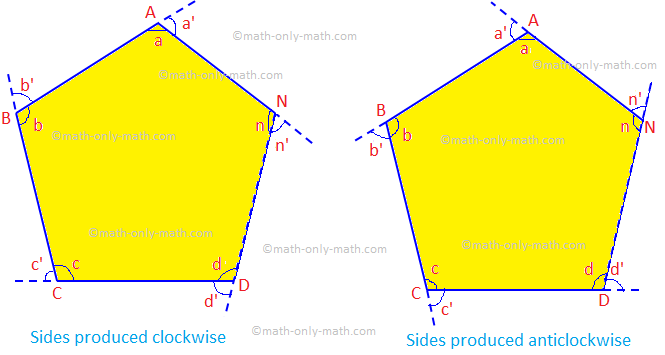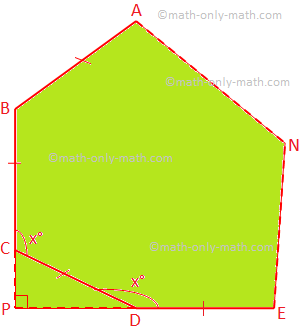Subscribe to our ▶️ YouTube channel 🔴 for the latest videos, updates, and tips.
Sum of the Exterior Angles of an n-sided Polygon
Here we will discuss the theorem of the sum of all exterior angles of an n-sided polygon and sum related example problems.
If the sides of a convex polygon are produced in the same order, the sum of all the exterior angles so formed is equal to four right angles.
Given: Let ABCD .... N be a convex polygon of n sides, whose sides have been produced in the same order.
To prove: The sum of the exterior angles is 4 right angles, i.e., ∠a’ + ∠b’ + ∠c’ + ..... + ∠n’ = 4 × 90° = 360°.
Proof:
|
Statement |
Reason |
|
1. ∠a + ∠a’ = 2 right angles. Similarly, ∠b + ∠b’ = 2 right angles, ...., ∠n + ∠n’ = 2 right angles. |
1. They form a linear pair. |
|
2. (∠a + ∠b + ∠c + ..... + ∠n) + (∠a’ + ∠b’ + ∠c’ + ..... + ∠n’) = 2n right angles. |
2. The polygon has n sides, and using statement 1. |
|
3. (2n – 4) right angles + (∠a’ + ∠b’ + ∠c’ + ..... + ∠n’) = 2n right angles. |
3. ∠a + ∠b + ∠c + ..... + ∠n = (2n – 4) right angles |
|
4. ∠a’ + ∠b’ + ∠c’ + ..... + ∠n’ = [2n - (2n – 4)] right angles. = 4 right angles = 4 × 90° = 360°. (Proved) |
4. From statement 3. |
Note:
1. In a regular polygon of n sides, each exterior angle = \(\frac{360°}{n}\).
2. If each exterior angle of a regular polygon is x°, the polygon has \(\frac{360}{x}\) sides.
3. The greater the number of sides of a regular polygon, the greater is the value of each interior angle and the smaller is the value of each exterior angle.
Solved examples on finding the sum of the interior angles of an n-sided polygon:
1. Find the measure of each exterior angle of a regular pentagon.
Solution:
Here, n = 5.
Each exterior angle = \(\frac{360°}{n}\)
= \(\frac{360°}{5}\)
= 72°
Therefore, the measure of each exterior angle of a regular pentagon is 72°.
2. Find the number of sides of a regular polygon if each of its exterior angles is (i) 30°, (ii) 14°.
Solution:
We know, total number of sides of a regular polygon is \(\frac{360}{x}\) where, each exterior angle is x°.
(i) Here, exterior angle x = 30°
Number of sides = \(\frac{360°}{30°}\)
= 12
Therefore, there are 12 sides of the regular polygon.
(ii) Here, exterior angle x = 14°
Number of sides = \(\frac{360°}{14°}\)
= 25\(\frac{5}{7}\), is not a natural number
Therefore, such a regular polygon does not exist.
3. Find the number of sides of a regular polygon if each of its interior angles is 160°.
Solution:
Each interior angle = 160°
Therefore, each exterior angle = 180° - 160° = 20°
We know, total number of sides of a regular polygon is \(\frac{360}{x}\) where, each exterior angle is x°.
Number of sides = \(\frac{360°}{20°}\) = 18
Therefore, there are 18 sides of a regular polygon.
4. Find the number of sides of a regular polygon if each interior angle is double the exterior angle.
Solution:
Let each exterior angle = x°
Therefore, each interior angle = 180° - x°
According to the problem, each interior angle is double the exterior angle i.e.,
180° - x° = 2x°
⟹ 180° = 3x°
⟹ x° = 60°
Therefore, the number of sides = \(\frac{360}{x}\)
= \(\frac{360}{60}\)
= 6
Therefore, there are 6 sides of a regular polygon when each interior angle is double the exterior angle.
5. Two alternate sides of a regular polygon, when produced, meet at right angles. Find:
(i) each exterior angle of the polygon,
(ii) the number of sides of the polygon
Solution:
(i) Let ABCD ...... N be a regular polygon of n sides and each interior angle = x°
According to the problem, ∠CPD = 90°
∠PCD = ∠PDC = 180° - x°
Therefore, from ∆CPD,
180° - x° + 180° - x° + 90° = 180°
⟹ 2x° = 270°
⟹ x° = 135°
Therefore, each exterior angle of the polygon = 180° - 135° = 45°.
(ii) Number of sides = \(\frac{360°}{45°}\) = 8.
6. There are two regular polygons with number of sides equal to (n – 1) and (n + 2). Their exterior angles differ by 6°. Find the value of n.
Solution:
Each exterior angle of the first polygon = \(\frac{360°}{ n – 1}\).
Each exterior angle of the second polygon = \(\frac{360°}{ n + 2}\).
According to the problem, each exterior angle of the first polygon and the second polygon differs by 6° i.e., \(\frac{360°}{ n – 1}\) - \(\frac{360°}{ n + 2}\).
⟹ 360° (\(\frac{1}{ n – 1}\) - \(\frac{1}{ n + 2}\)) = 6°
⟹ \(\frac{1}{ n – 1}\) - \(\frac{1}{ n + 2}\) = \(\frac{6°}{360°}\)
⟹ \(\frac{(n + 2) – (n – 1)}{(n – 1)(n + 2)}\) = \(\frac{1}{60}\)
⟹ \(\frac{3}{n^{2} + n - 2}\) = \(\frac{1}{60}\)
⟹ n\(^{2}\) + n – 2 = 180
⟹ n\(^{2}\) + n – 182 = 0
⟹ n\(^{2}\) + 14n – 13n – 182 = 0
⟹ n(n + 14) – 13(n + 14) = 0
⟹ (n + 14)(n - 13) = 0
Therefore, n = 13 (since n ≠ -14).
From Sum of the Exterior Angles of an n-sided Polygon to HOME PAGE
Didn't find what you were looking for? Or want to know more information about Math Only Math. Use this Google Search to find what you need.




New! Comments
Have your say about what you just read! Leave me a comment in the box below. Ask a Question or Answer a Question.